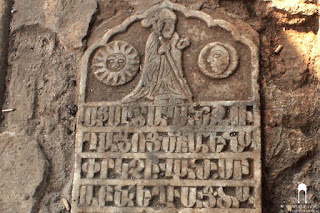 |
| Armenian cemetery, Surat twitter.com |
Located in a place in Surat city, Gujarat called 'Gulam Falia' close to the road leading to Katargam Gate, both the Dutch and Armenian cemeteries are protected monuments like the English cemetery in this sprawling city known for diamond and textile business.
Not lagging behind their competitors, the Dutch also had the tombs built on a grand scale. They come in different shapes and sizes and are more grandeur and majestic than other tombs. Example- the grandiose mausoleum of Baron Adrian Van Reede, the Director of the Dutch Company in the Indies. he wanted his mausoleum grand in style and dwarf the Oxendens in English cemetery. This one with double cupola of great size, with a gallery above and below rest on big columns. It has rich big windows with fine wood carvings and well ornamented frescos to accentuate its look.
In Surat city in the 17th century CE there was a large community of Armenians mostly doing business with the English company and their cemetery lies close to that of the Dutch. Unlike the British and the Dutch these people never built big ornamental super structures above the graves. However, But they had a large number of richly carved inscription slabs above grave.
 |
| inscription on he grave Armenian cemetery, Surat twitter.com |
Above image: Armenians of India: After, June 1688 a trade agreement was signed between the English company and the Armenian leader and merchant Khwaja Phanoos Kalandar. The Armenians never had a country on their own so the ESI had no qualms about maintaining trade relationship with them. During their prolonged stay in India for centuries, a number of several large and small Armenian settlements emerged across the land in places where the ESI had trading activities, etc. Agra, Surat, Mumbai, Kanpur, Chinsurah (an Armenian church was built in 1688 - Church of Holy Nazareth), Chandernagore, Calcutta, Saidabad, a suburb of Murshidabad, Chennai, Gwalior, Lucknow, and several other locations became their center of activities, In the 16th century on ward Armenians became part of business community in Surat. They built 2 churches in Surat and the last one (dedicated to Virgin Mary) came up in 1778. A holy church dedicated to Mary came up in Chennai in 1772 on the Armenian street (in George town), there were many medical professionals from this community and their contribution to India was vast, Belonging to the Caucasian community they toiled and -acquired significant economic and cultural prosperity> Apart. they had a close rapport with Indian merchants and the British..........
A beautiful mortuary chapel is part of the Armenian Cemeteries with unknown construction date) and is surrounded by ,roughly two hundred graves lie outside this chapel and just one being inside, dated 1695. He was the only son of Khwaja Phanoos Kalandar (he made a trade agreement deal with the EIC in June 1688), a reputed Armenian merchant and leader - native of Persia. He was buried inside the chapel because of his status in the society.
https://www.suratmunicipal.gov.in/TheCity/Cemeteries
https://en.wikipedia.org/wiki/Armenians_in_India









